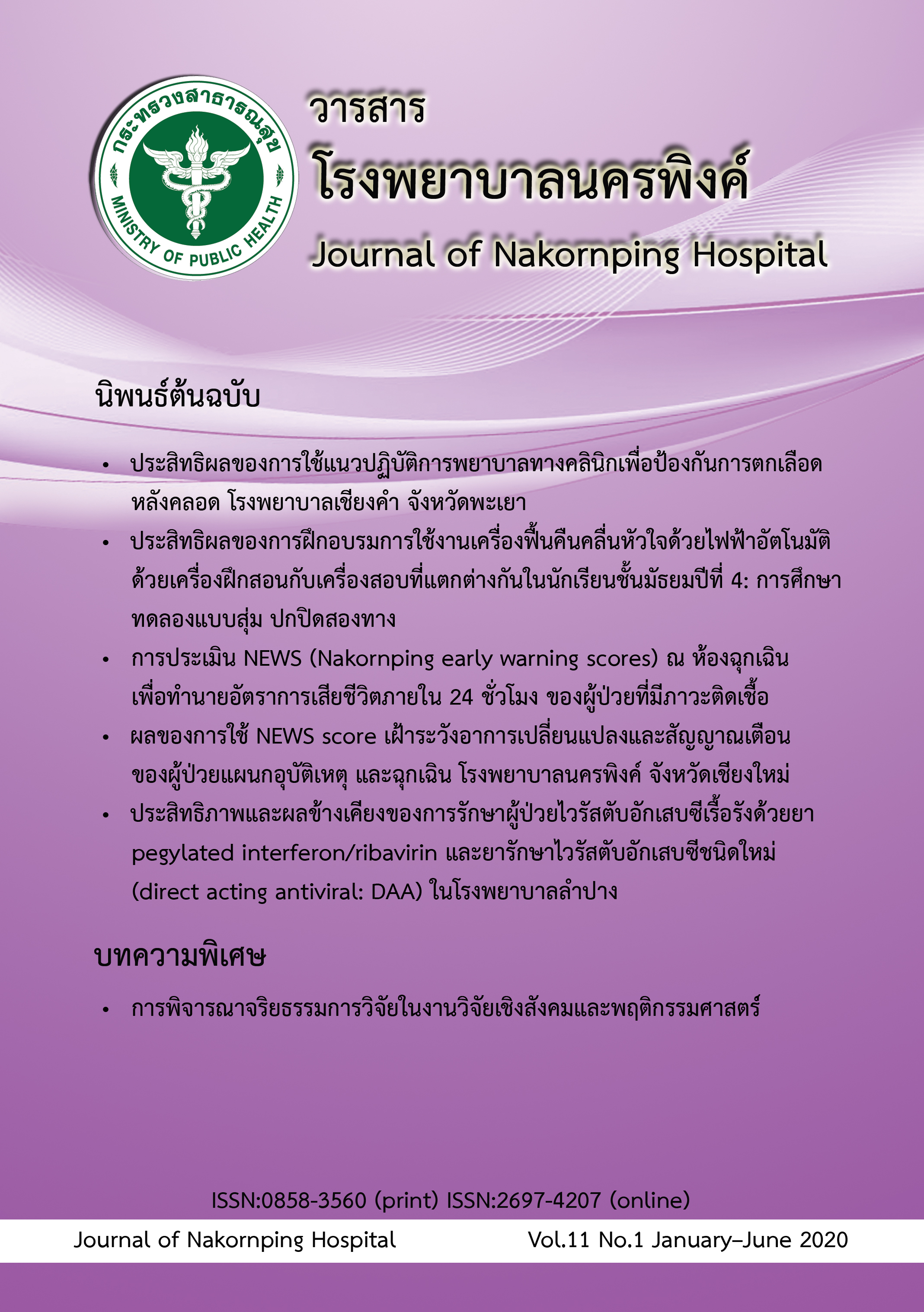Evaluation of a Nakornping Early Warning Scores (NEWS) at Emergency Department to predict 24 hours mortality of sepsis patients
Keywords:
NEWS, sepsis, ED triage, mortalityAbstract
Background: Nakornping hospital has been implemented Nakornping Early Warning Scores (NEWS) for screening in sepsis patients. But this tool is not widely used due to lack of confidence to its performances.
Objective: To evaluate prediction potential of NEWS score at emergency department (ED) triage station and 24-hour mortality and in-hospital mortality of sepsis patients and to explore other factors related to the mortality.
Methods: This is a prospective observational study of sepsis patients who visited ED during November 1, 2017 to January 31, 2018. Patients aged ≥ 16 years old and suspected sepsis were included. The patients who were not diagnosed of sepsis, refused treatment or unable to retrieve their data were excluded. The data was analyzed by using multivariable logistic regression to test a relationship between NEWS with other factors and mortality, sensitivity specificity and likelihood ration were used to analyse the performances.
Results: Three hundred and nine patients were enrolled; 21 cases (6.8%) were death in 24 hours and 140 cases (45.3%) were death during the admission. NEWS ≥4 had specificity, sensitivity and LH: 95.24%, 42.01% and 1.64 respectively. NEWS ≥4 was related to 24-hour mortality significantly with Adj. OR 10.02, p-value = 0.031. Other factors that related to the 24-hour mortality were male sex (Adj. OR 5.07, p-value =0.032), and alcoholism or had liver disease (Adj. OR=3.60, p-value =0.018). NEWS≥ 4 was related to in-hospital mortality significantly (Adj. OR = 2.50, p-value = 0.001). Other factors affecting in-hospital mortality were HIV (Adj. OR = 3.59, p-value = 0.033), cancer (Adj. OR = 5.11, p-value = 0.002), referred from local hospital (Adj. OR = 3.87, p-value <0.001).
Conclusion: NEWS ≥ 4 at ED triage can predict 24-hour mortality and in-hospital mortality of sepsis patients significantly.
References
Rhodes A, Evans LE, Alhazzani W, Levy MM, Antonelli M, Ferrer R, et al. Surviving Sepsis Campaign: International Guideline for management of sepsis and septic shock:2016. Crit Care Med. 2017;45(3):486-552.
Siddiqui S, Chua M, Kumaresh V, Choo R. A comparison of pre ICU admission SIRS, EWS and q SOFA scores for predicting mortality and length of stay in ICU. J Crit Care. 2017;41:191-3.
Churpek M, Snyder A, Han X, Sokol S, Pettit N, Howell M, et al. Quick Sepsis-related Organ Failure Assessment, Systemic Inflammatory Response Syndrome, and Early Warning Scores for Detecting Clinical Deterioration in Infected Patients outside the Intensive Care Unit. Am J Respir Crit Care Med. 2017;195(7):906-11.
Delgado-Hurtado JJ, Berger A, Bansal AB. Emergency department Modified Early Warning Score association with admission, admission disposition, mortality, and length of stay. J Community Hosp Intern Med Perspect. 2016;6(2):31456.
Reini K, Fredrikson M, Oscarsson A. The prognostic value of the Modified Early Warning Score in critically ill patient: a prospective, observational study. Eur J Anaesthesiol. 2012;29(3):152-7.
Kruisselbrink R, Kwizera A, Crowther M, Fox-Robichaud A, O'Shea T, Nakibuuka J, et al. Modified Early Warning Score (MEWS) Identifies Critical Illness among Ward Patients in a Resource Restricted Setting in Kampala, Uganda: A Prospective Observational Study. PLoS One. 2016;11(3):e0151408.
Yu S, Leung S, Heo M, Soto GJ, Shah RT, Gunda S,et al. Comparison of risk prediction scoring systems for ward patients: a retrospective nested case-control study. J Crit Care. 2014;18(3):R132.
Suwanpasu S, Sattayasomboon Y. Accuracy of Modified Early warning Scores for Predicting Mortality in Hospital: A systemic Review and Meta-analysis. J Intensive & Crit Care. 2016;2(1):20-9.
Burch VC, Tarr G, Morroni C. Modified Early Warning Score predicts the need for hospital admission and inhospital mortality. Emerg Med J. 2008;25(10):674-8.
Wang AY, Fang CC, Chen SC, Tsai SH, Kao WF. Perriarrest Modified Early Warning Score (MEWS) predicts the outcome of in-hospital cardiac arrest. J Formos Med Assoc. 2016;115(2):76-82.
Goldhill DR, MacNarry AF, Mandersloot G, AcGinley A. A physiologically-based early warning score for ward patients: the association between score and outcome. Anaesthesia. 2005;60(6):547-53.
Groarke JD, Gallagher J, Stack J, Aftab A, Dwyer C, McGovern R, et al. Use of an admission early warning score to predict patient morbidity and mortality and treatment success. Emerg Med J. 2008;25(12):803-6.
Armagan E, Yilmaz Y, Olmez OF, Simsek G, Gul CB. Predictive value of the modified Early Warning Score in a Turkish emergency department. Eur J Emerg Med. 2008;15(6):338-40.
Junhasavasdikul D, Theerawit P, Kiatboonsri S. Association between admission delay and adverse outcome of emergency medical patients. Emerg Med J. 2013; 30(4): 320-3.
Wheeler I, Price C, Sitch A, Banda P, Kellett J, Nyirenda M, et al. Early Warning Scores Generated in Developed Healthcare Settings Are Not Sufficient at Predicting Early Mortality in Blantyre, Malawi: A Prospective Cohort Study. PLoS One. 2013;8(3):e59830.
Vincent JL, Moreno R, Takala J, Willatts S, De Mendonça A, Bruining H, et al. The SOFA (Sepsis-related Organ Failure Assessment) score to describe organ dysfunction/failure. Intensive Care Med. 1996;22(7):707-10.
Downloads
Published
How to Cite
Issue
Section
License
The articles that had been published in the journal is copyright of Journal of Nakornping hospital, Chiang Mai.
Contents and comments in the articles in Journal of Nakornping hospital are at owner’s responsibilities that editor team may not totally agree with.



